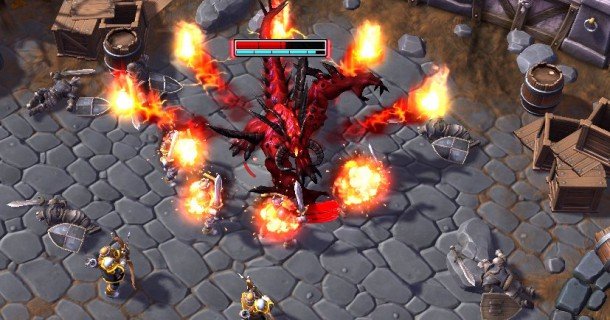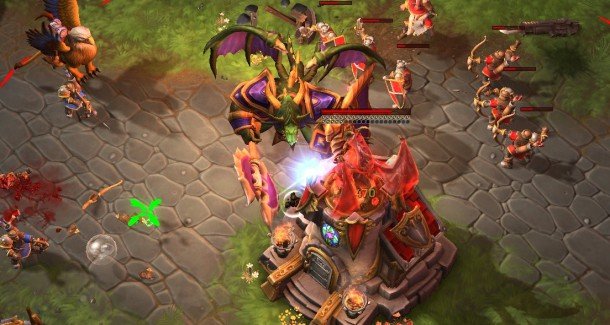Heroes of the Storm preview: entering the arena with Blizzard's all star cast of heroes

In Dota 2, invisibility is a game feature that players are invited to counter by drafting certain heroes or buying specific items. In Blizzard's new game, there are no items and you can't see the enemy's roster of heroes before the match. I asked Browder if he felt like these characters were a problem for the game given its current structure. His explanation was that the game is yet young, and that the community is still learning. Internally at Blizzard, the situation is a little different.
“We've got really good at dealing with invisible heroes with skillshots,” he tells me. “When you see that they're in the roster, you need to look for the shimmer.”
There's a slight mirage effect around invisible heroes at close range, faint enough that you're unlikely to see it unless you're looking for it. I also realised that it's possible to reveal invisible characters with damage, and started to look at each hero's tree of upgrades very differently. Uther, for example, can select a passive bonus that damages enemies immediately around him. Suddenly, staying in melee range became a viable anti-invisibility technique. The counters were there, but I needed to shake myself out of my 'Dota brain' to see them.
This is another example of the way that Heroes of the Storm encourages decision-making during the match, rather than before it. While Browder isn't opposed to adding a 'drafting' game mechanic – where teams take turns to select heroes – he wants to emphasise the strategic process within the match itself. “We want a lot of that in the game,” he says. “We want you to look at the enemy roster and say 'OK, I'm going to play differently now'.”
The only other concern that I've had during my time with the alpha regards combat feedback. I'm a stickler for feel, and I hold Blizzard to a high standard. After all, this is the company that made smacking a card down onto a virtual board in Hearthstone a tangible, physical and fun interaction. Diablo III sets an equally high benchmark, and even StarCraft II invests an enormous amount in small details that make battles feel lethal.

Heroes of the Storm isn't quite there yet. Initially, I attributed this to the game's design in general. Heroes have robust health pools, and skills are both more readily available and less immediately impactful than their equivalents in other games. You're in little danger of being chain-stunned to death at level one, and you're probably not going to be securing kills with Hail Mary skillshots either. The early phase of the game almost always involves a period of damage trading as players ping abilities back and forth across the frontline, but it rarely feels dangerous.
Browder acknowledges that the design of the game does factor in to this reduced sense of impact. “If we made the laning phase feel like it's really easy to gank somebody, then when we get into a teamfight everybody just explodes,” he says. “There's a tradeoff there that we have to deal with.”
The biggest gaming news, reviews and hardware deals
Keep up to date with the most important stories and the best deals, as picked by the PC Gamer team.
I can respect the nature of that tradeoff, because it does yield advantages elsewhere in the game. Map objectives mean that whole teams are likely to come together for five-on-five battles much earlier than they otherwise might, and this compensates for a reduced sense of individual potency. Also, the more of the game I play, the more I come to suspect that Heroes' problem with feedback can be attributed to something much simpler.
I think it's the audio mix. When we talk about 'feel' in games we are often talking, in effect, about sound. Diablo III's skeletons are 'crunchy'. Hearthstone's cards 'thump' onto the table. By comparison, Heroes' attacks and abilities sound muted, and are frequently overwhelmed by everything else going on – the bellowing announcer, the music, the hubbub of minions fighting. I find this heartening, in a sense, because it's a relatively straightforward fix – and something I believe that Blizzard will be able to address before the game launches. Nonetheless, I'd like to see them make it a priority.

Blizzard have yet to finalise much about the game's social features, including the exact amount of power players will have to communicate with each other – famously abusable power, given the genre's reputation. At the moment, you can only talk to you own team. This is likely to change, one way or another.
“I have a lot of sympathy for users who can't handle being flamed in chat,” Browder tells me. “But I'm also sympathetic to players who want to talk freely in the game. I'm not sure where we need to go at this point. It's not Hearthstone. We don't have a one-size-fits-all approach here at Blizzard.”
As it is, I've noticed that Heroes of the Storm doesn't provoke chatter—or flaming—as much as other games. What you need to be doing at a given point is generally intuitive enough that players come together without much prevarication. Communication is still vitally important for competitive play, but being able to coordinate silently with strangers is key, I think, to Heroes' appeal. It's what makes it a level playing field for veterans to play with or against their newcomer friends. I've found that my experience with other games in the genre has been as much a hindrance as a help, and that speaks to the fact that Blizzard have created something legitimately new despite the familiar trappings. It's a welcome sense of novelty, albeit the one that has taken time to uncover.
As much as I suspect that Blizzard's game will prompt division among the lane-pushing hardcore, I think it has the power to bring people together, too. This is an opportunity for a fresh start within a genre that has become notorious for its factionalism, and I'm looking forward to watching Heroes of the Storm's nascent community transform it from an interesting set of new ideas into a competitive game with a life of its own.
Joining in 2011, Chris made his start with PC Gamer turning beautiful trees into magazines, first as a writer and later as deputy editor. Once PCG's reluctant MMO champion , his discovery of Dota 2 in 2012 led him to much darker, stranger places. In 2015, Chris became the editor of PC Gamer Pro, overseeing our online coverage of competitive gaming and esports. He left in 2017, and can be now found making games and recording the Crate & Crowbar podcast.


